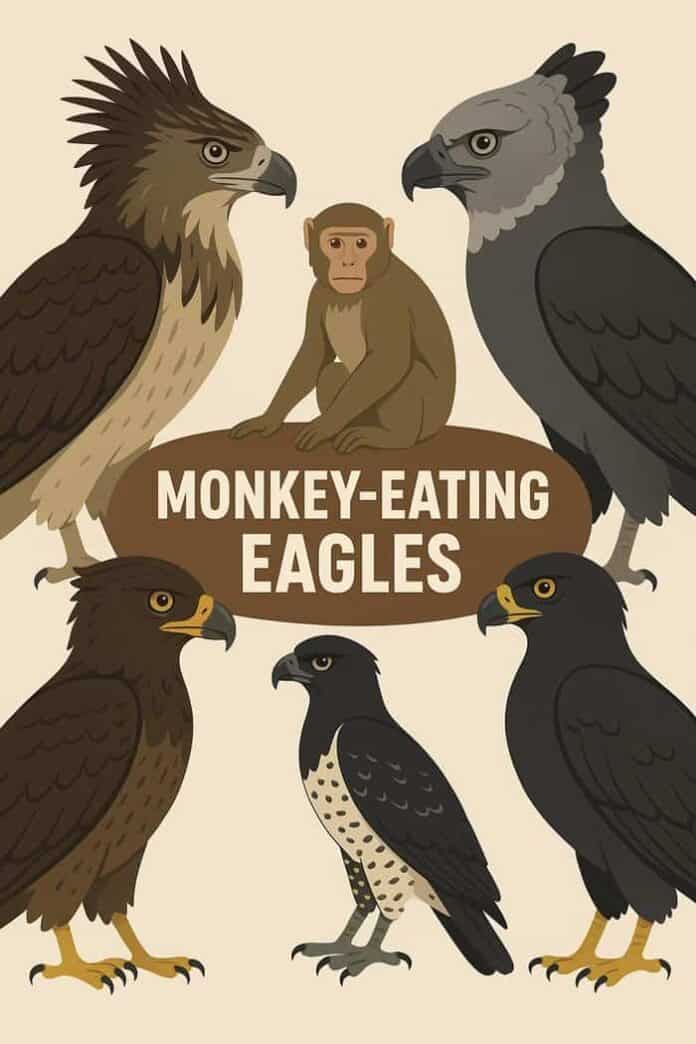
Deep within the lush, tangled rainforests of the tropics, a rare class of hunters’ lives—the monkey-eating eagles. These types of eagles aren’t your average Birds of Prey. While most eagles chase rabbits or fish, this elite group has taken on a trickier challenge: primates. Agile, clever, and fast-moving, monkeys are no easy catch, but these birds were built for the job.
Picture this: a massive eagle swoops silently through the canopy, then in a flash, snatches a 20-pound monkey mid-leap. Its talons crush with the force of a grizzly bear’s bite. Its wings, broad yet nimble, slice between trees like a jet weaving through a canyon. These eagles are nature’s special ops, designed for speed, power, and precision in one of the toughest hunting arenas on Earth.
Key Takeaways
- Size & Power: Monkey-eating eagles rank among the world’s largest and most powerful raptors.
- Specialized Hunters: Five primary species have evolved specifically to hunt primates: the Philippine Eagle, Harpy Eagle, Crowned Eagle, Black Hawk-Eagle, and Crested Eagle.
- Unique Adaptations: These birds possess extraordinarily large talons, specialized wing shapes, and enhanced visual capabilities.
- Global Distribution: They hunt across three continents Asia, South America, and Africa.
- Habitat Specialists: All 5 species operate primarily in dense rainforest canopies.
- Hunting Success: Their specialized adaptations make them incredibly efficient predators.
These remarkable types of birds challenge our understanding of predator-prey relationships in forest ecosystems. Each species has carved out its own niche, developing specific hunting strategies and physical adaptations to target different monkey species in their respective habitats.
From the Philippine Eagle’s pursuit of long-tailed macaques to the Harpy Eagle’s preference for howler monkeys, each species tells a unique story of evolutionary adaptation.
Table of Contents
The World’s Most Famous Monkey-Hunting Eagles
1. Philippine Eagle — The Real Monkey Hunter
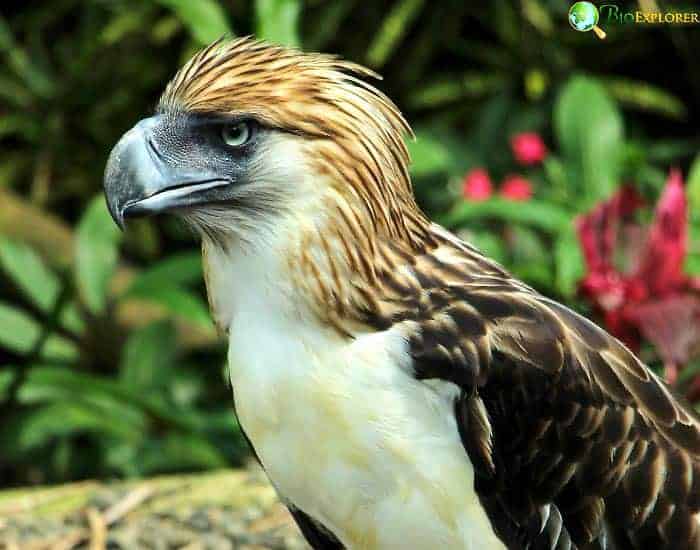
The Philippine Eagle is one of the world’s most powerful birds of prey. It’s often called the “Monkey-Eating Eagle” because it hunts monkeys, such as the long-tailed macaque, which is found in the rainforests of the Philippines. With sharp eyes and clever hunting skills, this eagle rules the treetops.
This eagle has a thick crown of feathers on its head that looks like a lion’s mane. Its wide, strong wings help it fly quickly and quietly through the forest. Its feet are huge, and its claws are sharp enough to grab and hold monkeys tightly.
Instead of chasing its prey for long distances, the Philippine Eagle uses surprise attacks. It watches from high branches, waiting for the perfect moment to swoop down. Because it can fly without making a sound, its prey often doesn’t notice until it’s too late.
It inhabits parts of the forest where monkeys are abundant. With excellent eyesight, it can see even small movements far away, even in the shade of trees. It flies fast and twists through the trees with amazing skill, able to follow monkeys that try to escape.
Each time it hunts, it may adjust its plan to match the monkey’s actions. It uses its powerful claws to grab the monkey in midair or from a tree. With smart thinking and strong tools, the Philippine Eagle is one of the best hunters in the world.
Suggested Reading:
What Do Eagles Eat?
2. Harpy Eagle — The Amazon’s Monkey Hunter
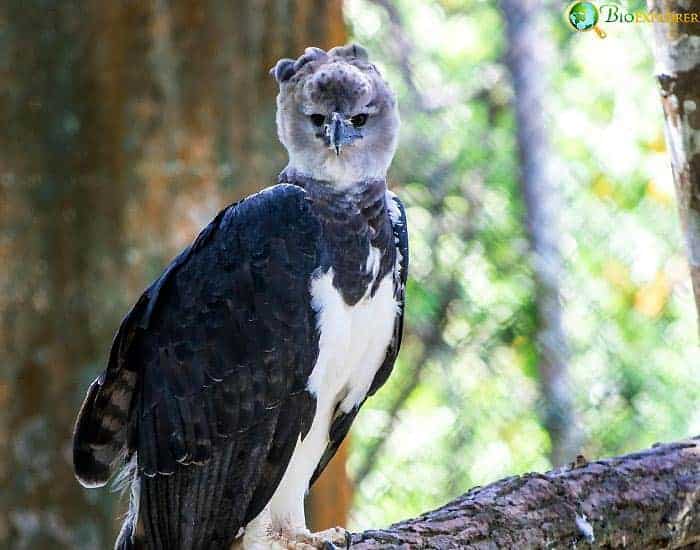
The Harpy Eagle is one of the strongest birds in the Americas. It lives deep in the Amazon rainforest and is known for hunting monkeys, such as howlers and capuchins. With powerful features and sharp instincts, it’s built to rule the treetops.
This eagle has huge, strong claws – about the size of a grizzly bear’s and uses them to grab its prey. Its broad, short wings help it fly between trees without getting stuck. Its muscular body gives it the strength to lift monkeys that are nearly as heavy as itself.
To catch its prey, the Harpy Eagle employs a clever strategy. It hides on a high branch and waits quietly until a monkey comes close. Then it dives down in a flash, using silent flight and strong legs to snatch the animal with amazing force.
It primarily hunts in the tall parts of the forest, where monkeys tend to reside. Its sharp eyes can spot even a slight movement far away. Thanks to its special wing shape, it can change direction quickly while flying, which helps it follow fast-moving monkeys through the trees.
The Harpy Eagle is fast, quiet, and very strong. It doesn’t just hunt with power, it hunts with patience, perfect timing, and skill. That’s what makes it one of the top monkey hunters in the rainforest.
3. Crowned Eagle — Africa’s Expert Monkey Hunter

The Crowned Eagle is Africa’s top monkey hunter. It inhabits the dense forests of central and eastern Africa, primarily hunting red-tailed and blue monkeys. With its strong body and sharp hunting skills, it’s built for life in the treetops.
This eagle gets its name from the crown of feathers on its head, which gives it a regal look. Its short, strong wings help it move quickly between trees. It also has powerful legs and sharp claws, perfect for catching monkeys that try to escape.
To hunt, the Crowned Eagle waits silently in the forest canopy. It hides among the branches and watches for monkeys moving below. When the time is right, it dives down fast, grabbing its prey with a tight grip.
It prefers forests with diverse monkey species and sticks to its chosen hunting areas. Its sharp eyes help it follow monkeys as they jump through the trees. With great speed and perfect aim, it can hunt even in crowded forest spaces.
The Crowned Eagle doesn’t just fly well, it hunts with focus and strength. It’s a smart and powerful bird that rules the African treetops.
4. Black Hawk-Eagle — The Stealth Monkey Hunter
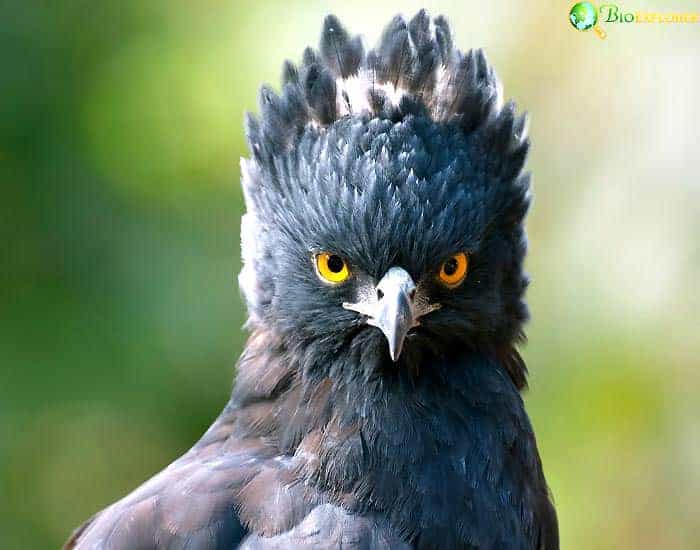
The Black Hawk-Eagle is smaller than its monkey-hunting cousins, but don’t let its size fool you. This clever bird is a stealth expert, specially adapted to hunt small monkeys like marmosets, squirrel monkeys, and even young howlers in thick forest habitats.
Its body is slim and light, built for speed and sharp turns. Its short wings help it fly quickly through tight spaces between trees. Its talons are just the right size to grab smaller monkeys without missing a beat.
This eagle doesn’t chase loudly or crash through the trees. Instead, it sneaks up quietly, gliding through the lower and middle parts of the forest. Once close enough, it strikes fast, often before the monkey knows what’s coming.
The Black Hawk-Eagle sticks to smaller hunting grounds where small monkeys are readily available. It watches carefully, using trees and shadows for cover. When it attacks, it moves with lightning speed, twisting and turning through branches to land the perfect catch.
Quick, quiet, and clever, the Black Hawk-Eagle proves you don’t have to be the biggest to be one of the best. Its silent style and fast strikes make it one of the jungle’s most skilled monkey hunters.
5. Crested Eagle — Guardian of the Canopy
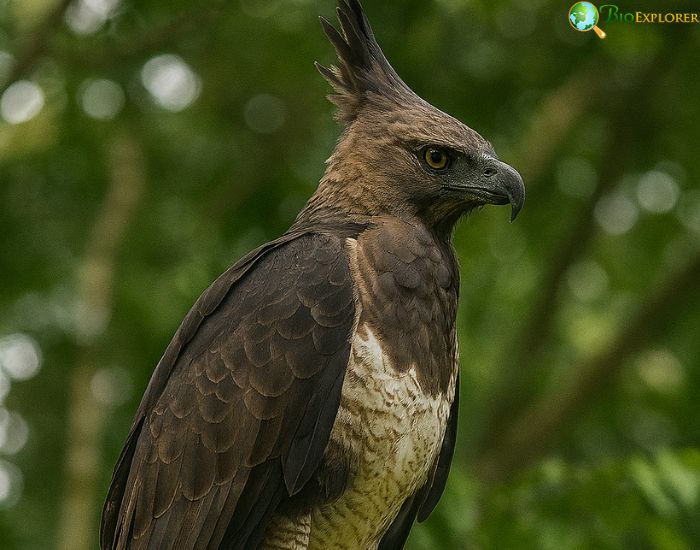
The Crested Eagle is a quiet but skilled hunter that lives high in the rainforest canopy. It primarily hunts small to medium-sized monkeys, such as capuchins, tamarins, and woolly monkeys. With sharp vision and quick moves, it’s perfectly suited for life in the treetops.
This eagle is medium-sized, with a distinct, feathered crest on its head that gives it a unique appearance. Its strong feet and talons are designed to grip and hold monkeys tightly. Its wings are shaped for gliding smoothly through crowded forest branches.
Instead of chasing its prey immediately, the Crested Eagle employs a strategic plan. It perches quietly on a high branch, watching carefully. When a monkey gets close, it swoops in with a silent, fast strike that catches its prey by surprise.
It prefers mature forests where monkey families are common. Its sharp eyes help it follow monkeys through thick leaves and twisting branches. Thanks to its strong grip and quick moves, it can hunt with great accuracy even in the densest parts of the jungle.
The Crested Eagle may not be the biggest, but it’s one of the smartest hunters in the canopy. With stealth, strength, and precision, it rules the high branches like a silent guardian.
How Do Monkey-Eating Eagles Hunt?
Monkey-eating eagles aren’t just strong; they’re perfectly built for the job. Every part of their body, from their sharp eyes to their powerful feet, helps them hunt monkeys high in the treetops. Let’s explore how nature turned these birds into expert primate hunters.
Their talons are like jungle traps extra large, curved, and built to grab and hold monkeys tightly. Their feet are strong and covered in scales, which help them keep a firm grip while also protecting them from bites and scratches. Once they catch a monkey, escape is almost impossible.
To move through the thick forest, these eagles rely on short, wide wings that let them turn quickly and zip between branches. Their feathers are designed to keep flight nearly silent, so they can sneak up without being heard. When it’s time to strike, they launch fast and twist midair to follow prey through the trees.
Their eyes are forward-facing, providing them with excellent depth perception, much like a pair of binoculars. They can spot the smallest movement from far away and quickly shift focus as the monkey jumps from branch to branch. In a world of fast-moving targets and leafy cover, their eyesight gives them the upper hand.
With a deadly grip, quiet wings, and sharp vision, monkey-eating eagles are master hunters of the forest. Every feature works together, helping them snatch monkeys from the treetops with speed, precision, and power.
Hunting Techniques
Monkey-eating eagles don’t just rely on strength; they hunt with strategy, patience, and precision. Over time, they’ve developed smart techniques to outwit their quick and clever prey. From silent ambushes to lightning-fast chases, every move is carefully planned.
Ambush is their go-to move. These eagles perch quietly in the canopy, blending into the leaves and shadows. They watch monkey groups from above, waiting for just the right moment. By staying still and hidden, they utilize the forest’s cover to approach without being seen or heard.
When it’s time to strike, they move like thunder from the sky. Their first attack is sudden and fierce. With perfect aim, they grab their prey using powerful talons, locking in with precision. They know exactly where to strike, often immobilizing the monkey in seconds and keeping control even if it struggles.
Sometimes, if the prey tries to run, they launch a short, explosive chase. These eagles don’t waste energy flying long distances. Instead, they cut off escape routes, twist through branches, and use the forest layout to their advantage. Every turn is calculated to keep the upper hand.
Fast, focused, and full of finesse, these hunting methods show that monkey-eating eagles are more than muscle. They’re masters of timing, stealth, and skill.
Monkey-Eating Eagles’ Hunting Grounds
Monkey-eating eagles don’t just hunt wherever they please, they need forests that fit their style. These birds depend on specific canopy conditions, hunting heights, and large territories to find and catch their clever, tree-dwelling prey.
The perfect hunting ground begins with a dense upper canopy, filled with mature trees and thick foliage. These tall trees offer hiding spots for ambushes, sturdy branches for perching, and just enough space between them for quick bursts of flight. A forest with multiple layers of vegetation creates a three-dimensional hunting field, where eagles can move above, around, or between trees depending on the monkey’s path.
Larger eagles, like the Harpy and Philippine Eagle, prefer to hunt in the upper canopy, where bigger monkeys move. Smaller eagles, such as the Black Hawk-Eagle, often stay in the middle layers, where smaller primates travel. Each bird adjusts its height based on the monkey species it targets and the shape of the surrounding forest.
When it comes to territory, size matters. The Harpy Eagle needs a large hunting range to support its appetite for monkeys. The Philippine Eagle, being a solo forest giant, also roams across wide territories. In contrast, the Black Hawk-Eagle does fine in a smaller patch of forest. Crowned Eagles take up mid-sized areas, while Crested Eagles prefer to patrol defined sections of the canopy where monkey activity is high.
These eagles aren’t just shaped by the forest, they’re part of its design. Every wingbeat, every perch, every strike is tied to the forest they call home.
Across the rainforests of Asia, Africa, and the Americas, monkey-eating eagles have carved out a unique and thrilling role, the ultimate predators of primates. From the Philippine Eagle’s silent ambush of macaques to the Harpy Eagle’s powerful chase through Amazonian trees, each one has evolved with stunning precision to meet the challenge of catching quick, clever prey high above the forest floor.
These birds are more than hunters, they’re the result of millions of years of fine-tuning. Every sharp talon, every quiet wingbeat, every calculated strike shows just how deeply nature can shape a creature to fit its role. In the never-ending game of predator versus prey, monkey-eating eagles prove that evolution doesn’t just build survivors, it builds specialists. And in the canopy, no one plays the part better.
![]()


















